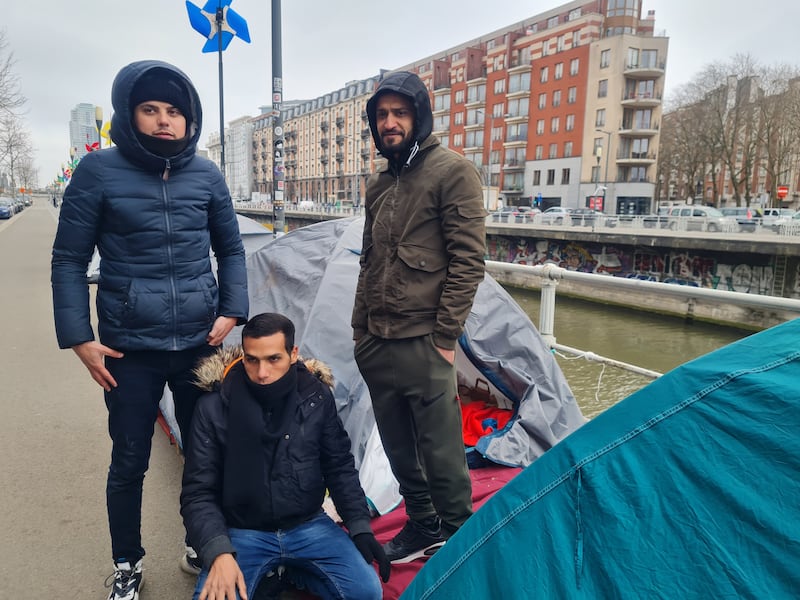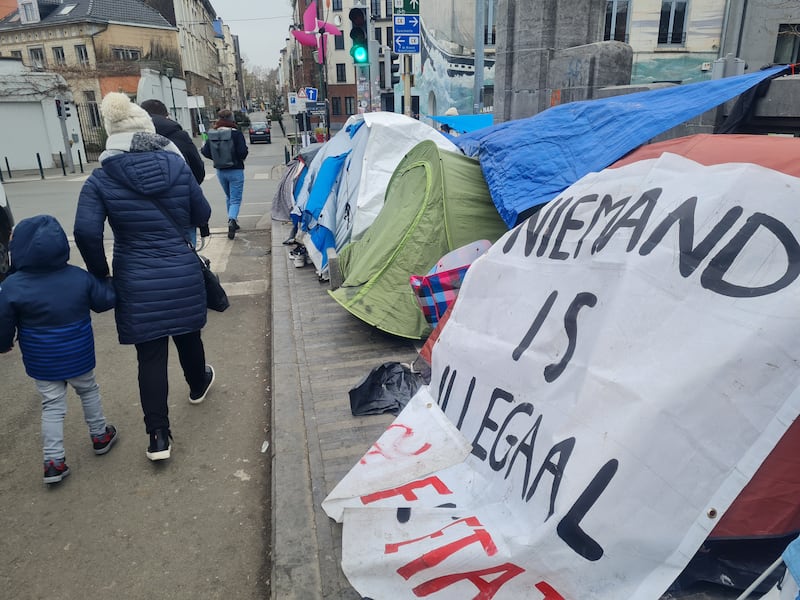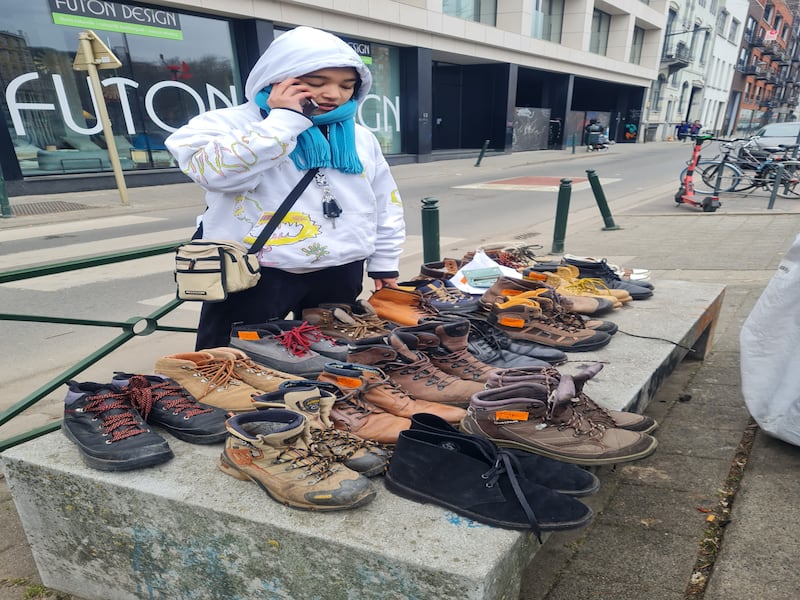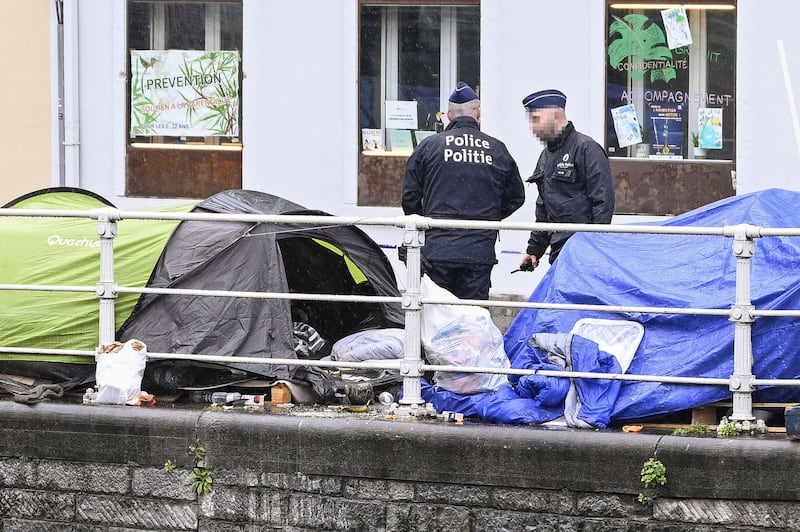His hands stuffed into his armpits against the cold, Ali lists the names of the countries he travelled through on his journey into the heart of Europe.
“Iran, Turkey, Bulgaria, Serbia, Croatia, Herzogovina, Slovenia, Italia, France, Belgique,” he recites, through a black scarf that muffles his face below his intense green eyes.
This epic journey began six months ago in Afghanistan. “Big problem with Taliban,” the 25 year- old explains. “I am Afghan soldier. Afghan commando.”
Ali says he has been sleeping rough for three months since he lodged an asylum application here in Belgium, which has struggled to provide the accommodation it is obliged to under international law as a 42 per cent post-Covid surge in applications last year collided with a reduced number of beds and an overwhelmed bureaucracy.

Mostly, those seeking refuge have fled Afghanistan, Syria, Palestinian territories, the former Belgian colony of Burundi or the closed dictatorship of Eritrea - the most common countries of origin for refugee applicants here.
The young man spoke among a huddle of people waiting outside the Little Castle, a canal-side former barracks in imposing brick that serves as the main reception centre for asylum seekers in the Belgian capital, in a scene overhung with the heavy smell of damp.
[ Boats, tents, park benches: how EU countries are accommodating Ukrainian refugeesOpens in new window ]
Slumped figures laid out in sleeping bags and makeshift tent encampments became a common sight along this canal in recent months, as asylum seekers without accommodation clustered at a place where they hoped they could receive help.
Despite a series of court rulings that found the Belgian state in breach of its obligations, the number of homeless asylum seekers reached between 2,000 and 3,000 last week, according to a spokesman from Belgium’s asylum agency, Fedasil.
“It’s not a situation we would wish for, and we are doing our best to increase the accommodation,” said spokesman Benoit Mansy.
“Military buildings, old people’s homes… we work to find these buildings. But it’s complicated because we can’t find the budget, the staff,” said Mansy. “Teachers, nurses, social workers… they have so many needs, it takes time.”

Women and children are prioritised, meaning that those who remain homeless for longest are lone men.
But at crunch points over the winter, families and even unaccompanied minors were sleeping rough too, according to Ana Relinque Lopez, a migration adviser at the Croix-Rouge de Belgique, which provides healthcare to the homeless asylum seekers and operates some accommodation centres.
“I think it was November last year it arrived to the point where even minors and families were in the streets,” she said.
Host families have taken in Ukrainians, who do not need to go through the asylum claim procedure because the EU granted them automatic rights to live and work in the bloc in the weeks after Russia’s invasion.
But Ukrainians too have been affected by the lack of emergency accommodation, and have been found sleeping rough around Brussels-South railway station, which serves as their main arrival point after long journeys by train from the east.
“They were arriving in the Gare de Midi… We tried to collaborate with other organisations that have centres for for homeless people, to try to find a solution,” Relinque Lopez said. But beds could not always be found.
As the temperature in Brussels plunged well below freezing over the winter, with pounding rain and bouts of hail and sleet, the health of those seeking refuge deteriorated.
The Red Cross reported cases of tuberculosis and diphtheria among the homeless asylum seekers, while a serious problem of scabies spread among hundreds of people who occupied a disused building together for several weeks. Mental health breakdowns are also a challenge.

“The conditions are horrible and not liveable. I slept out here last night, and I woke up every two hours from the cold,” said Tjara Visser (21), a local student who has been working in shifts as a volunteer to assist homeless asylum seekers along the canal.
She spoke as she distributed winter boots to two men who were wearing sneakers too small for them, with their socked heels emerging from the shoes’ worn-down backs.
“We have people from Yemen, Sierra Leone, Guinea, Gambia, Congo… There’s a few people that have been on the street for six months now,” Visser said.
Shortly after she spoke, police moved in to break up the tent encampment, which had taken over the pavements of the busy city street and was developing a semi-permanent air, with sinks and portaloos set up by donors.
At its peak, the encampment became a ragtag community of several hundred people, living four to a tent in the long rows of makeshift shelters. Many of them had previously been evicted from the squatted building where the scabies broke out.

After the tents were broken up, Belgium’s state secretary for asylum and migration, Nicole de Moor, announced that all those sleeping there had been transferred to reception centres.
But she acknowledged the risk, as NGOs fear, that they will simply be replaced by new arrivals who are forced to sleep rough.
“The reception crisis is not over,” de Moor warned. “Reforms are needed for a structural solution.”
On Thursday, Belgian prime minister Alexander De Croo announced that a major part of the solution would be an increase in deportations.
A large number of those who lodge asylum claims in Belgium have already been registered in another EU country that they passed through on their journey. Under EU law, they should be transferred back to the country of their initial claim.
But resentment among border states such as Greece and Italy about having to shoulder the greatest burden for geographic reasons means inter-EU co-operation has broken down, a major point of contention as EU home affairs ministers met for talks in Brussels this week.
Following a meeting of the Belgian cabinet, De Croo promised to increase the forced deportation of failed asylum seekers to their countries of origin, as well as to apply the EU’s Dublin regulation more strictly. This means more transfers of people back to the EU countries where they first arrived.
“We are going to focus more on outflow and more deportations,” De Croo said.




















